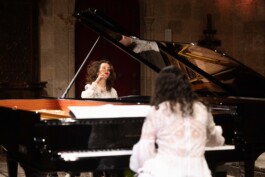
photo Miquel González / Festival Perelada.
Katia y Marielle Labèque llevan ya muchos años siendo uno de los dúos pianísticos más respetados del panorama internacional. Desde su debut en el festival hace treinta años, las francesas han recorrido el mundo con una propuesta ecléctica, a caballo del piano clásico tradicional y el contemporáneo, sin dejar de incursionar incluso otros estilos
dos imágenes especulares de una misma alma musical, …..una interpretación iridiscente y espectacular.
- PLATEA MAGAZINE, 13 july 2025
Carlos García Reche
Le jardin féerique. La ejecución de Ma Mère l’Oye destacó por su riqueza narrativa y color sonoro; la Fantasía en fa menor, de Schubert, por su profundidad introspectiva; y la obra de Glass, por su complejidad rítmica y precisión técnica. El mundo narrativo de los cuentos, la profundidad emocional romántica y la abstracción hipnótica contemporánea. Tres formas de fantasía, tres lenguajes que, en manos de este dúo excepcional, se han convertido en un recorrido de alta intensidad artística. un espacio interior donde la música despertaba emociones, recuerdos y sueños.Las pianistas francesas han sido capaces de construir una atmósfera casi etérea y «los jardines se iluminan con la vida, la música y el amor.»Su lectura de Schubert ha preservado el equilibrio entre tensión y lirismo, sin caer en el exceso emocional ni tampoco en la frialdad. El acorde final ha dejado una sensación de silencio suspendido, casi religioso, como si el público necesitara un instante para asimilar lo que había escuchado. Ha sido el momento de hacer un pequeño receso…... el jardín encantado se ha convertido ahora en laberinto hipnótico, donde la imaginación se desplaza por estructuras sonoras de una fuerza persistente. Hoy, en este jardín imaginario habitado por hadas, emociones y formas, las hermanas Labèque han demostrado que la fantasía, lejos de ser una evasión, puede ser un camino de retorno hacia lo esencial.
- TODA LA MUSICA, 13 july 2025
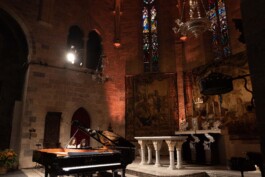
photo Miquel González / Festival Perelada.
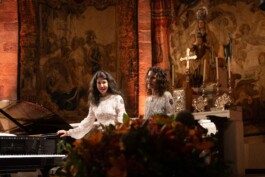
photo Miquel González / Festival Perelada.
"Quatre mans de contes"
Katia i Marielle Labèque tornen al fes#val de Peralada 31 anys després amb el fantasiós «Le jardin féerique»
les pianistes van oferir una imatge de puresa i serenitat per captivar als espectadors amb les seves quatre mans. Com si fessin màgia, van explicar contes i els van fer arribar a través d’una experiència sensorial...
Tan cert com revelador. Katia i Marielle Labèque han desenvolupat una carreraimpressionant amb actuacions de primer nivell a tot el món.
- Diari de Girona, 12 july 2025
Tatiana Pérez
La Repubblica / Robinson - La rivoluzione delle sorelle Labèque - Luca Valtorta 11.05.2025
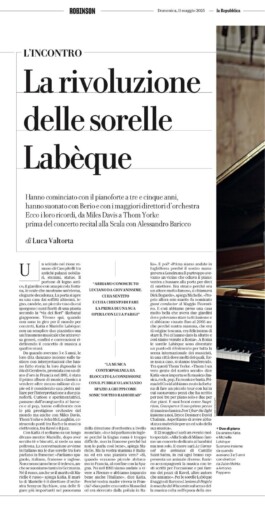
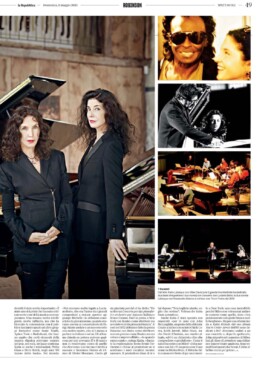
Liberation / Katia et Marielle Labeque Soeurs de son / Eric Dahan, 04.03.2024
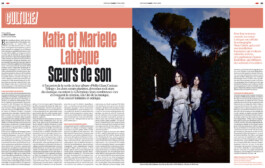
The New York Times / These Sisters Have Transformed the Piano Duo. - Roslyn Sulcas 25.10.2020

These Sisters Have Transformed the Piano Duo
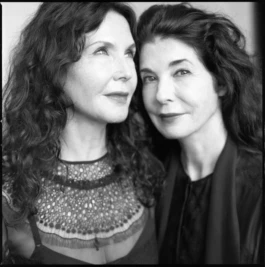
Katia, left, and Marielle Labèque have ventured into jazz, Baroque, modernist and experimental genres. Their latest album is a new arrangement of a Philip Glass opera. photo Brigitte Lacombe
AHETZE, France — “Oh, look!” said the pianist Katia Labèque, pushing aside some neatly ironed clothes hanging on a rack.
Behind the clothes, which were behind the boiler in the utility room of her home and studio here in French Basque Country, was a poster advertising concerts last year at the Philharmonie in Paris. It showed Katia and her sister, Marielle — both with dark hair flowing, glamorously dressed — and listed three programs: five centuries of Basque music; a Stravinsky and Debussy double bill; an evening with three art-rock auteurs, Thom Yorke, Bryce Dessner and David Chalmin.
“We’re ridiculous,” said Katia. “This is the only poster we have, and it’s hidden.”
The poster suggests the wildly varied musical interests of the Labèque sisters, who for over 50 years have been playing — and enlarging — the two-piano repertory. They have interpreted traditional classical and Romantic works, to brilliant effect, but have also ventured into jazz, Baroque, modernist and experimental genres — commissioning scores, inventing projects and testing their limits. Their latest recording, out this week, is a newly arranged two-piano adaptation of Philip Glass’s opera “Les Enfants Terribles.”
“What always struck me with both of them is that, although they are very different human beings, they both have this endless curiosity about everything, not just music,” said Simon Rattle, the music director of the London Symphony Orchestra and a frequent Labèques collaborator.
Katia, 70, and Marielle, 68, have been inventing themselves since they were teenagers. First taught by their mother, an Italian piano teacher and pupil of the renowned pianist Marguerite Long, the sisters moved at 11 and 13 from their hometown, Hendaye (not far from here), to attend the prestigious Paris Conservatory.
“They taught you the tricks, but not the love of music that we learned from our parents,” Marielle said. “Maybe that helped us develop our sense of independence, the desire to move in the world on our own terms.” (The sisters, interviewed mostly in French, also speak fluent English, Italian and Spanish.)
They decided against the solo careers that their fiercely competitive training had shaped them for. “From the moment we left — and it was 1968, the year of revolution of the students — we said, ‘Let’s do something maybe not so conventional,’” Katia said.
They decided to play together.
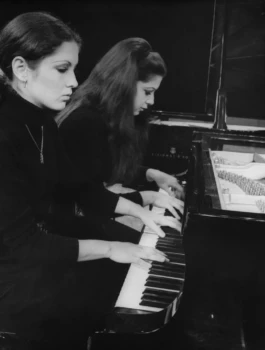
After studying at the Paris Conservatory, the Labèques made the unconventional choice to play as a duo.Credit...Keystone/Hulton Archive, via Getty Images
“They took a time-honored form, the double piano, which had become slightly less fashionable, and breathed entirely new life into it,” said Deborah Borda, the president and chief executive of the New York Philharmonic.
Despite their almost uncanny unity onstage — “it’s a mystery beyond sisterhood,” Mr. Rattle said — the Labèques have very different personalities. In the interview, Katia exuded energy and enthusiasm, while Marielle remained calm and reflective. But they agreed that they never really had a career plan. After deciding to perform together, they joined the Conservatory’s chamber music graduate class to develop their dual repertory, and worked as ensemble musicians with Félix Blaska’s dance company.
One day, while they were working on Olivier Messiaen’s “Visions de l’Amen,” Messiaen, who taught composition at the Conservatory, knocked on the door. After listening for a bit, he asked if one of the sisters would record the work with his wife. Even then, they showed surprising strength of purpose.
“We said, ‘No, we are just starting out and we can’t begin by dividing,’” Katia recalled. But eventually Messiaen asked them to record the work together, which led to encounters with the composers Gyorgy Ligeti, Pierre Boulez and Luciano Berio, whom they boldly approached, asking him to compose a work for them. Berio suggested they give the French premiere of his double piano concerto, which they subsequently played all over the world.
Their international breakthrough came with a 1980 recording of “Rhapsody in Blue,” which was a best seller but led to some harsh criticism from parts of the classical music establishment.
“The concert halls were closed to Gershwin,” Katia said. “People would say, ‘He is not a serious composer.’ The same thing was true 30 years later, when we started to play Philip Glass.”
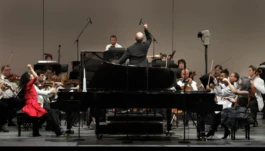
The sisters, brilliant in traditional repertory, played Mendelssohn with Bernard Labadie and the Los Angeles Philharmonic in 2013.Credit...Lawrence K. Ho/Los Angeles Times, via Getty Images
They were also sometimes ribbed for their designer outfits and glossy image. But Chad Smith, the chief executive of the Los Angeles Philharmonic, said he loved that the Labèques “have a complete vision. Lighting creates a beautiful environment; clothes, too. They come with a theatrical approach and have shown the false narrative that it’s less serious if you engage in the visual.”
Over the years, they have pursued Baroque music, on Silbermann-model period-style pianofortes made for them and with the ensemble Il Giardino Armonico; ragtime; traditional Basque music; and jazz. Katia once lived with the jazz musician John McLaughlin and played in his band, and counts Miles Davis — who wrote two songs for her — and Billie Holiday as influences. The sisters have plunged deep into experimental terrain in “Minimalist Dream House,” an ongoing series of concerts and recordings with Mr. Chalmin, who is Katia’s partner, and Mr. Dessner.
“They have an extremely broad vision of what they can do in a concert hall, and they treat everyone with the same respect,” said Mr. Dessner, best known as a member of the indie-rock band the National.
The coronavirus pandemic paused a number of their projects. A concerto by Nico Muhly, which should have premiered at the New York Philharmonic in early June, is now scheduled for the Paris Philharmonie on Nov. 12; a program with Mr. Dessner and the soprano Barbara Hannigan will probably be pushed to 2022.
But one thing they could work on in quarantine was “Les Enfants Terribles,” arranged by Mr. Glass’s longtime collaborator, Michael Riesman. During the initial lockdown the Labèques worked separately to prepare the score — Marielle lives with her husband, the conductor Semyon Bychkov, about nine miles from the house Katia and Mr. Chalmin share — but sent recordings back and forth and spoke frequently with Mr. Riesman about changes.
“We wanted more of the story and the dramatic parts,” Katia said. “It was so odd that it’s a story of confinement.” After the lockdown restrictions were relaxed in May, they were able to practice together, and recorded the work in the state-of-the-art studio at Katia’s house.
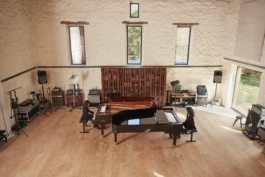
The Labèques in the studio this month.Credit...Umberto Nicoletti
“I love the way they play Philip Glass,” said Mr. Riesman. “They have the right style, the right approach. They don’t overly dramatize or emote.”
Mr. Muhly said, “They are actually much more involved in everything than most people of their stature. They email you about material; they are totally involved. The rhythms of the day are organized around an unspeakably rigorous work ethic, but there is something really elegant about the way they live their lives which flows into music and food and their extended family of artists.”
The sisters’ trick, according to Katia, is their constant desire to change and learn. “We never want to rely on what we’ve done,” she said. “We have always tried to be relentlessly in the present.”